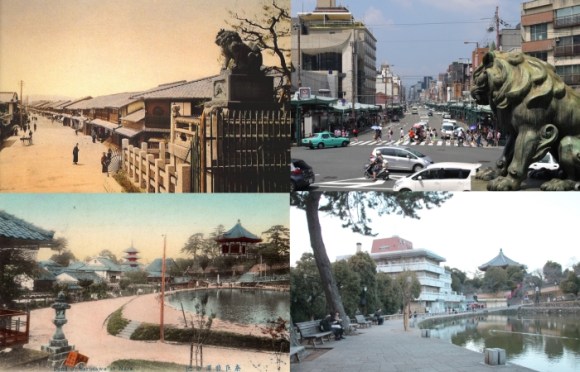
Japanese commenters aren’t so impressed with modern cityscapes, but are they just being nitpicky?
We all know that cities’ appearances change with time, but sometimes it’s easy to forget just how much things have changed. In general, we like to think things are improving, but sometimes you have to wonder if everything is, in fact, getting better as time goes on.
One thread on the anonymous Japanese social network site 2Channel recently compared photos of locations in Japanese cities from about 100 years ago with their corresponding contemporary views and asked: “Can Japan no longer afford to consider its scenery?”
Before we take a look at the photos themselves, we feel that it’s only fair to provide some context: For one thing, we have to consider the devastation wrought by both the Great Kanto Earthquake in 1923 and World War II. If a building was destroyed or rebuilt later in the 20th century, it only makes sense that the newer versions or replacements wouldn’t have the same look at those of old.
On the other hand, it’s hard to deny that, at least in these photos, some of the scenery of Japanese cities used to be a lot prettier.
▼ Maru no Uchi
▼ Yoshiwara (in modern-day Taito-ku)
So, what do Japanese commenters think? Well, quite a few of them agreed with the general thesis, many responding to the original question with a simple, “Nope,” meaning that Japan no longer cared (or at least could no longer afford to care) about its scenery when building.
▼ Nihon-bashi
▼ Imperial Theater
Others took a slightly more conservative approach. One commenter wrote, “100 years ago was the Meiji Period. I know the scenery was more beautiful then, but there’s nothing to be done about it.” Another pointed out that rebuilding after the war was done as quickly as possible, which would inevitably lead to aestheticism being somewhat overlooked, though the original poster replied that while it made sense right after the end of the conflict, “even after 70 years have passed, we’re still putting up nothing but buildings that look like squares of tofu.”
▼ Imperial Theater interior
▼ Asakusa and the Cloud-Surpassing Tower
▼ Yokohama Station
One argument proposed in defense of modern architecture had more to do with safety than beauty. “Didn’t older buildings have issues with durability?” asked one commenter. “If we’d stuck with the old style, we wouldn’t be able to produce buildings with excellent durability.” While this is a fair point, others responded by pointing out that the Imperial Hotel withstood the Great Kanto Earthquake, suggesting that it’s possible to strike an even balance.
▼ Shijodori in Kyoto
▼ Sarusawa Pond in Nara
▼ Sarusawa Pond from another angle
In the end, most the Japanese commenters agreed that they don’t necessarily want to see a bunch of old European-style buildings across the country, just a bit more consideration given to how the scenery actually looks.
▼ Osaka City Hall
▼ Imperial Palace
We can certainly see where these commenters are coming from — there are a lot of “tofu-esque” buildings out there! And looking at these photos, it’s easy to agree that in the past, some of the buildings were a lot prettier, though we’re also not sure how much of this is just selection bias.
But what do you guys think? Should Japanese architects put more effort into creating pretty scenery? Or is Japan doing a good enough job as it is?

 Akihabara then and now: Photos show how Tokyo neighborhood has changed over the past 10 years
Akihabara then and now: Photos show how Tokyo neighborhood has changed over the past 10 years Japanese video shows what life was like in Tokyo and Mt Fuji over 100 years ago
Japanese video shows what life was like in Tokyo and Mt Fuji over 100 years ago 122-year-old video of downtown Tokyo shows how much Japan’s capital has changed【Video】
122-year-old video of downtown Tokyo shows how much Japan’s capital has changed【Video】 Nephew receives SD card after his uncle passes away, finds treasure trove of gems from the past
Nephew receives SD card after his uncle passes away, finds treasure trove of gems from the past Four photos, five years – A father’s beautiful pictures of his daughter growing up at Nara temple
Four photos, five years – A father’s beautiful pictures of his daughter growing up at Nara temple Starbucks Japan ready to get Year of the Horse started with adorable drinkware and plushies【Pics】
Starbucks Japan ready to get Year of the Horse started with adorable drinkware and plushies【Pics】 7 great places to see Mt. Fuji from without having to climb it
7 great places to see Mt. Fuji from without having to climb it Japanese government to subsidize domestic travel this summer to boost the ailing tourism industry
Japanese government to subsidize domestic travel this summer to boost the ailing tourism industry This hot springs town in Japan sets fire across a mountain every winter in a beautiful tradition
This hot springs town in Japan sets fire across a mountain every winter in a beautiful tradition Cyberpunk anime meets traditional culture in Ghost in the Shell gold leaf Japanese changing screens
Cyberpunk anime meets traditional culture in Ghost in the Shell gold leaf Japanese changing screens Sanrio’s Cinnamoroll serves popcorn at this super rare vending machine in Japan
Sanrio’s Cinnamoroll serves popcorn at this super rare vending machine in Japan Cappuccino Ramen becomes super popular in Japan, but is it worth the hype?
Cappuccino Ramen becomes super popular in Japan, but is it worth the hype? Kyoto samurai house wants to share its history of seppuku, torture and gold coins with visitors
Kyoto samurai house wants to share its history of seppuku, torture and gold coins with visitors Final Fantasy’s Yoshitaka Amano illustrates exclusive Japan-only Magic: The Gathering card
Final Fantasy’s Yoshitaka Amano illustrates exclusive Japan-only Magic: The Gathering card Beef bowl king Yoshinoya to start serving ramen this summer with new beefy mazesoba
Beef bowl king Yoshinoya to start serving ramen this summer with new beefy mazesoba Disillusionment at Tsukiji’s tourist-target prices led us to a great ramen restaurant in Tokyo
Disillusionment at Tsukiji’s tourist-target prices led us to a great ramen restaurant in Tokyo Japan may add Japanese language proficiency, lifestyle classes to permanent foreign resident requirements
Japan may add Japanese language proficiency, lifestyle classes to permanent foreign resident requirements Lacquerware supplier to emperor of Japan and Pokémon team up for new tableware
Lacquerware supplier to emperor of Japan and Pokémon team up for new tableware Starbucks Japan releases new zodiac chilled cup drink for 2026
Starbucks Japan releases new zodiac chilled cup drink for 2026 7-Eleven Japan’s ramen-cooking robot whipped us up a bowl of noodles【Taste test】
7-Eleven Japan’s ramen-cooking robot whipped us up a bowl of noodles【Taste test】 Hello Kitty Choco Egg figures are an adorable trip through three periods of Japanese pop culture【Pics】
Hello Kitty Choco Egg figures are an adorable trip through three periods of Japanese pop culture【Pics】 Japan’s otoshidama tradition of giving kids money at New Year’s gets a social welfare upgrade
Japan’s otoshidama tradition of giving kids money at New Year’s gets a social welfare upgrade Japan’s human washing machines will go on sale to general public, demos to be held in Tokyo
Japan’s human washing machines will go on sale to general public, demos to be held in Tokyo 7-Eleven Japan starts new temporary luggage storage service in over 300 branches
7-Eleven Japan starts new temporary luggage storage service in over 300 branches Starbucks teams up with 166-year-old Kyoto doll maker for Year of the Horse decorations【Photos】
Starbucks teams up with 166-year-old Kyoto doll maker for Year of the Horse decorations【Photos】 Tokyo considering law requiring more trash cans following litter increase in heavily touristed area
Tokyo considering law requiring more trash cans following litter increase in heavily touristed area Tokyo’s Tsukiji sushi neighborhood asks tour groups to stay away for the rest of the month
Tokyo’s Tsukiji sushi neighborhood asks tour groups to stay away for the rest of the month Nintendo’s Kirby now delivering orders at Kura Sushi restaurants, but not in Japan
Nintendo’s Kirby now delivering orders at Kura Sushi restaurants, but not in Japan Tokyo event lets you travel back in time, for free, to celebrate 100 years since Showa era start
Tokyo event lets you travel back in time, for free, to celebrate 100 years since Showa era start Sanrio theme park in Japan announces plans to expand into a Sanrio resort
Sanrio theme park in Japan announces plans to expand into a Sanrio resort Stamina-destroying “Paralysis Noodles” are Tokyo’s newest over-the-top ramen innovation
Stamina-destroying “Paralysis Noodles” are Tokyo’s newest over-the-top ramen innovation Survey asks foreign tourists what bothered them in Japan, more than half gave same answer
Survey asks foreign tourists what bothered them in Japan, more than half gave same answer Japan’s deadliest food claims more victims, but why do people keep eating it for New Year’s?
Japan’s deadliest food claims more victims, but why do people keep eating it for New Year’s? We deeply regret going into this tunnel on our walk in the mountains of Japan
We deeply regret going into this tunnel on our walk in the mountains of Japan Studio Ghibli releases Kodama forest spirits from Princess Mononoke to light up your home
Studio Ghibli releases Kodama forest spirits from Princess Mononoke to light up your home Major Japanese hotel chain says reservations via overseas booking sites may not be valid
Major Japanese hotel chain says reservations via overseas booking sites may not be valid Put sesame oil in your coffee? Japanese maker says it’s the best way to start your day【Taste test】
Put sesame oil in your coffee? Japanese maker says it’s the best way to start your day【Taste test】 No more using real katana for tourism activities, Japan’s National Police Agency says
No more using real katana for tourism activities, Japan’s National Police Agency says The top 10 annoying foreign tourist behaviors on trains, as chosen by Japanese people【Survey】
The top 10 annoying foreign tourist behaviors on trains, as chosen by Japanese people【Survey】 Starbucks Japan reveals new sakura drinkware collection, inspired by evening cherry blossoms
Starbucks Japan reveals new sakura drinkware collection, inspired by evening cherry blossoms Japanese company caught out for over-processing autumn leaves photo at popular tourist site
Japanese company caught out for over-processing autumn leaves photo at popular tourist site
Leave a Reply